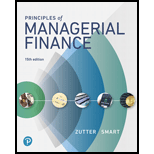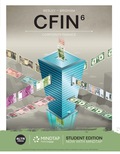
Integrative Case 1
Merit Enterprise Corp.
Sara Lehn, chief financial officer of Merit Enterprise Corp., was reviewing her presentation one last time before her upcoming meeting with the board of directors. Merit’s business had been brisk for the past 2 years, and the company’s CEO was pushing for a dramatic expansion of Merit’s production capacity. Executing the CEO’s plans would require $4 billion in new capital in addition to $2 billion in excess cash built up by the firm. Sara’s immediate task was to brief the board on options for raising the needed $4 billion.
Unlike most companies its size, Merit had maintained its status as a private company, financing its grow1h by reinvesting profits and, when necessary, borrowing from banks. Whether Merit could follow that same strategy to raise the $4 billion necessary to expand at the pace envisioned by the firm’s CEO was uncertain, although it seemed unlikely to Sara. She had identified the following two options for the board to consider.
Option 1: Merit could approach JPMorgan Chase, a bank that had served Merit well for many years with seasonal credit lines as well as medium-term loans. Lehn believed that JPMorgan was unlikely to make a $4 billion loan to Merit on its own, but it could probably gather a group of banks together to make a loan of this magnitude. However, the banks would undoubtedly demand that Merit limit further borrowing and provide JPMorgan with periodic financial disclosures so that it could monitor Merit’s financial condition as Merit expanded its operations.
Option 2: Merit could convert to public ownership, issuing stock to the public in the primary market. With Merit’s excellent financial performance in recent years, Sara thought that its stock could command a high price in the market and that many investors would want to participate in any stock offering that Merit conducted.
Becoming a public company would also allow Merit, for the first time, to offer employees compensation in the form of stock or stock options, thereby creating stronger incentives for employees to help the firm succeed. Sara also knew, however, that public companies faced extensive disclosure requirements and other regulations that Merit had never had to confront as a private firm. Furthermore, with stock trading in the secondary market, who knew what kind of individuals or institutions might wind up holding a large chunk of Merit stock?
To Do
- a. Discuss the pros and cons of option 1, and prioritize your thoughts. What are the most positive aspects of this option, and what are the biggest drawbacks?
- b. Do the same for option 2.
- c. Which option do you think Sara should recommend to the board, and why?
Want to see the full answer?
Check out a sample textbook solution
Chapter 2 Solutions
Gitman: Principl Manageri Finance_15 (15th Edition) (What's New in Finance)
Additional Business Textbook Solutions
Financial Accounting (12th Edition) (What's New in Accounting)
Marketing: An Introduction (13th Edition)
Financial Accounting, Student Value Edition (5th Edition)
Horngren's Accounting (12th Edition)
Engineering Economy (17th Edition)
- 1. Waterfront Inc. wishes to borrow on a short-term basis without reducing its current ratio below 1.25. At present its current assets and current liabilities are $1,600 and $1,000 respectively. How much can Waterfront Inc. borrow?arrow_forwardQuestion 3Footfall Manufacturing Ltd. reports the following financialinformation at the end of the current year:Net Sales $100,000Debtor’s turnover ratio (based onnet sales)2Inventory turnover ratio 1.25Fixed assets turnover ratio 0.8Debt to assets ratio 0.6Net profit margin 5%Gross profit margin 25%Return on investment 2%Use the given information to fill out the templates for incomestatement and balance sheet given below:Income Statement of Footfall Manufacturing Ltd. for the year endingDecember 31, 20XX(in $)Sales 100,000Cost of goodssoldGross profitOther expensesEarnings beforetaxTax @50%Earnings aftertaxBalance Sheet of Footfall Manufacturing Ltd. as at December 31, 20XX(in $)Liabilities Amount Assets AmountEquity Net fixed assetsLong termdebt50,000 InventoryShort termdebtDebtorsCashTOTAL TOTALarrow_forwardSolve correctly and no aiarrow_forward
- You are considering an option to purchase or rent a single residential property. You can rent it for $5,000 per month and the owner would be responsible for maintenance, property insurance, and property taxes. Alternatively, you can purchase this property for $204,500 and finance it with an 80 percent mortgage loan at 4 percent interest that will fully amortize over a 30-year period. The loan can be prepaid at any time with no penalty. You have done research in the market area and found that (1) properties have historically appreciated at an annual rate of 2 percent per year, and rents on similar properties have also increased at 2 percent annually; (2) maintenance and insurance are currently $1,545.00 each per year and they have been increasing at a rate of 3 percent per year; (3) you are in a 24 percent marginal tax rate and plan to occupy the property as your principal residence for at least four years; (4) the capital gains exclusion would apply when you sell the property; (5)…arrow_forwardIf data is unclear or blurr then comment i will write it.arrow_forwardI need answer typing clear urjent no chatgpt used pls i will give 5 Upvotes.arrow_forward
 Financial Accounting: The Impact on Decision Make...AccountingISBN:9781305654174Author:Gary A. Porter, Curtis L. NortonPublisher:Cengage Learning
Financial Accounting: The Impact on Decision Make...AccountingISBN:9781305654174Author:Gary A. Porter, Curtis L. NortonPublisher:Cengage Learning Financial AccountingAccountingISBN:9781305088436Author:Carl Warren, Jim Reeve, Jonathan DuchacPublisher:Cengage Learning
Financial AccountingAccountingISBN:9781305088436Author:Carl Warren, Jim Reeve, Jonathan DuchacPublisher:Cengage Learning
 Cornerstones of Cost Management (Cornerstones Ser...AccountingISBN:9781305970663Author:Don R. Hansen, Maryanne M. MowenPublisher:Cengage Learning
Cornerstones of Cost Management (Cornerstones Ser...AccountingISBN:9781305970663Author:Don R. Hansen, Maryanne M. MowenPublisher:Cengage Learning Survey of Accounting (Accounting I)AccountingISBN:9781305961883Author:Carl WarrenPublisher:Cengage Learning
Survey of Accounting (Accounting I)AccountingISBN:9781305961883Author:Carl WarrenPublisher:Cengage Learning





